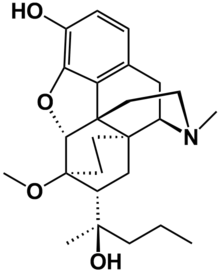- Dihydroetorphine
-
Dihydroetorphine 
Systematic (IUPAC) name (5R,6R,7R,9R,13S,14R)-7-[(R)-2-Hydroxypentan-2-yl] -6-methoxy-17-methyl-4,5-epoxy-6,14-ethanomorphinan-3-ol Clinical data Pregnancy cat. ? Legal status Schedule II Identifiers CAS number 14357-76-7 
ATC code None PubChem CID 107765 DrugBank DB01450 ChemSpider 96924 
Chemical data Formula C25H35NO4 Mol. mass 413.5497 g/mol SMILES eMolecules & PubChem  (what is this?) (verify)
(what is this?) (verify)Dihydroetorphine was developed by K.W.Bentley at McFarlan-Smith in the 1960s[1] and is a potent analgesic drug (painkiller),[2] which is used mainly in China. It is a derivative of the more well-known opioid etorphine, which is used as a very potent veterinary painkiller and anesthetic medication, primarily for the sedation of large animals such as elephants, giraffes and rhinos.
Dihydroetorphine is a semi-synthetic opioid, used mainly as a strong painkiller for humans.[3] It is several thousand times stronger than morphine (between 1000x and 12000x more potent depending what method is used for comparison),[4] although it is poorly absorbed when taken orally. Sublingual forms of dihydroetorphine are used in China at doses ranging from 20 to 180µg, and are reported to cause strong analgesia and relatively mild side effects compared to other opioids, although all the usual opioid side effects such as dizziness, sedation, nausea, constipation, and respiratory depression can occur. Transdermal patches of dihydroetorphine have also been developed.[5]
Dihydroetorphine is considered to be somewhat less addictive than many other opioids, and is also sometimes used in China as a substitute maintenance drug for opioid addicts,[6] in a similar way to how the related drug buprenorphine is used in western nations.[7][8]
References
- ^ Bentley,K.W.; Hardy,D.G. Journal of the American Chemical Society, 1967, vol. 89, p. 3281 - 3292
- ^ Martin, TJ; Hairston, CT; Lutz, PO; Harris, LS; Porreca, F (1998). "Anti-allodynic actions of intravenous opioids in the nerve injured rat: Potential utility of heroin and dihydroetorphine against neuropathic pain."". European Journal of Pharmacology 357 (1): 25–32. doi:10.1016/S0014-2999(98)00531-7. PMID 9788770.
- ^ Lewis, JW; Husbands, SM. (2004). "The orvinols and related opioids--high affinity ligands with diverse efficacy profiles". Current Pharmaceutical Design 10 (7): 717–32. doi:10.2174/1381612043453027. PMID 15032698.
- ^ Bentley, KW; Hardy, DG (1967). "Novel analgesics and molecular rearrangements in the morphine-thebaine group. 3. Alcohols of the 6,14-endo-ethenotetrahydrooripavine series and derived analogs of N-allylnormorphine and -norcodeine". Journal of the American Chemical Society 89 (13): 3281–92. doi:10.1021/ja00989a032. PMID 6042764.
- ^ Ohmori, S; Morimoto, Y. (Winter 2002). "Dihydroetorphine: a potent analgesic: pharmacology, toxicology, pharmacokinetics, and clinical effects". CNS Drug Reviews 8 (4): 391–404. PMID 12481194.
- ^ Qin Bo-Yi (1998). "Advances in dihydroetorphine: From analgesia to detoxification". Drug Development Research 39 (2): 131–134. doi:10.1002/(SICI)1098-2299(199610)39:2<131::AID-DDR3>3.0.CO;2-Q.
- ^ Gerak, LR; Gauthier, CR; France, CR. (Apr 2003). "Discriminative stimulus and antinociceptive effects of dihydroetorphine in rhesus monkeys". Psychopharmacology 166 (4): 351–9. doi:10.1007/s00213-002-1268-y. PMID 12601499.
- ^ Husbands, SM; Lewis, JW. (Mar 2003). "Opioid ligands having delayed long-term antagonist activity: potential pharmacotherapies for opioid abuse". Mini Reviews in Medicinal Chemistry 3 (2): 137–44. doi:10.2174/1389557033405395. PMID 12570846.

This analgesic-related article is a stub. You can help Wikipedia by expanding it.
